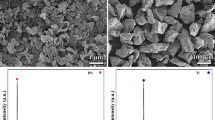Abstract
Results of a study of a material prepared by impregnating boron carbide with aluminum are reported. A shortcoming of this composite material is that it tends to degrade (at a different rate depending on the conditions) into a powder. Introduction of boron and magnesium diboride enhances the material stability; however, specimens high in aluminum carbide are the most prone to degradation. It is assumed that the process of degradation involves hydrolysis of residual (free) aluminum in the presence of aluminum carbide.
Similar content being viewed by others
REFERENCES
A. A. Zabolotsky, “Structure and properties formation of metal matrix composites,” Comp. Sci. Tech., 45(3), 233-240 (1992).
P. S. Kislyi, N. I. Bodnaruk, and M. S. Borovikova, Cermets [in Russian], Naukova Dumka, Kiev (1985).
A. J. Pyzik and D. R. Beaman, “Al - B - C-phase development and effects on mechanical properties of B4C_Al composites,” J. Am. Ceram. Soc., 78(2), 275-284 (1995).
Author information
Authors and Affiliations
Rights and permissions
About this article
Cite this article
Neshpor, V.S., Zaitsev, G.P., Zhuravlev, S.V. et al. A Composite Material in the Al – B – C System. Refractories and Industrial Ceramics 44, 89–91 (2003). https://doi.org/10.1023/A:1024758926179
Issue Date:
DOI: https://doi.org/10.1023/A:1024758926179




